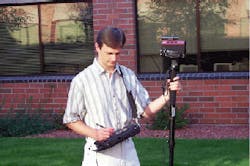The murderer had left a clue—a bloody fingerprint on the bed sheet. Homicide detectives would use the world's best-known method of identifying a killer, charting the loops and whorls of skin ridges that are unique to every individual and then comparing their findings from the crime scene with fingerprints taken from a suspect. But in this case there was a problem. The busy pattern of the bed sheet made it difficult to see the contour of the fingerprint.
Detectives from the Los Angeles County Sheriff's Department looked for help. They found it at NASA's Jet Propulsion Laboratory (Pasadena, CA). Using imaging techniques they had perfected while enhancing photographs of distant planets, JPL scientists were able to subtract the background pattern and leave only the fingerprint.
What was space-age technology in the late 1980s is now the classic example of imaging in crime laboratories. The use of fingerprints to tie suspects to the scene of a crime dates back to the 19th century, but it only works if detectives can actually see the fingerprint. When the print is on a surface with a regular pattern—a check, a $20 bill, or the bed sheet—crime labs need to remove the pattern to make the print visible. To do that, they digitize a color picture and convert it to a gray-scale image. Then they run it through software that uses fast Fourier transform algorithms to remove the background pattern. After that, adjusting brightness and contrast gives a clear fingerprint, one ready to be compared to others on file.
"There's just no way you can do that with conventional photography or conventional darkroom techniques. That can only be done electronically," says Special Agent David Mishoe, a forensic analyst with the North Carolina State Bureau of Investigation's Latent Evidence Section (Raleigh, NC).
Mishoe, who serves on the Technical Working Group on Imaging Technologies of the Federal Bureau of Investigation, says the use of imaging in the crime lab is evolving rapidly, mostly in terms of computer software and storage capabilities that allow labs to manage evidence better. Just being able to digitize images and store them on CD-ROM disks helps his department solve crimes.
"If you have things that are difficult to visualize, image-enhancement technologies help out," says Barry Fisher, who took the bloody fingerprint to JPL several years ago, before his department bought the equipment to do that sort of imaging themselves. Fisher is crime laboratory director for the Los Angeles County Sheriff`s Department and past president of the American Society of Crime Laboratory Directors (ASCLD; St. Petersburg, FL). "It's just another tool. My experience is that there's no one silver bullet. Every time some new technology is added, it just enables you to characterize evidence a little better."
Most of the equipment that police and crime labs are working with doesn't seem revolutionary. Investigators use alternate light sources, including lasers, particularly in the ultraviolet, under which blood, semen, bone chips, hair, and fibers will fluoresce. Bandpass filters of various wavelengths allow police to photograph evidence that might not have been visible before. Infrared microscopes attached to spectrographs allow forensic scientists to determine the chemical makeup of a fiber or a paint chip. Video cameras let them look at a sample in real time on a monitor and adjust the light to make sure an image is clear, before a frame-grabber card captures it for a computer.
"I wouldn't call it truly, truly revolutionary," says Fisher. "It's just a natural progression of where things have been going."
Something that's become as commonplace as a video camera—which can enlarge an image on a built-in screen—can be important to a detective at a crime scene, says Master Sgt. Hayden Baldwin of the Illinois State Police Bureau of Crime Scene Services (Joliet, IL). "If I can't see it, I can't collect it. If I can't see it, I can't identify it," he says.
Platform of the future
Some groups are working to bring more high technology to the crime scene, part of a post-Cold War attempt to move military developments to commercial use. For instance, the Department of Energy's Pacific Northwest National Laboratory (Richland, WA) is working with Mnemonic Systems Inc. (Washington, DC) on adapting a system called Scene Pro (see Fig. 1). The system would include a portable computer that can tie into digital video and still cameras, a barcode scanner for marking evidence, and specialized sensors. The original head-mounted unit used by the military has been replaced with a pen-based, hand-held computer at the request of police, with software for note-taking and drawing. It would include a laser rangefinder that could be used to map a crime scene and pinpoint where evidence was found. Eventually, the system would be able to tie into the Global Positioning System, as well as a library of maps and architectural drawings.
"I truly see it as a platform for the future for all types of input and sensing devices," says Kevin Lothridge, director of special projects for the National Forensic Sciences Technology Center (St. Petersburg, FL), which is also working on Scene Pro. The center was formed in 1995 by the ASCLD as a nonprofit group that supports crime labs and offers training for forensic personnel (see Fig. 2).
The National Institute of Justice (Washington, DC), an arm of the federal Department of Justice, is also working with the United States Army and the New York State Police to develop a teleforensics system, based on telemedicine systems used in Bosnia, to allow investigators to view a crime scene over a remote video linkup.
Baldwin, the crime scene expert, thinks teleforensics is a great idea if it keeps people from tramping all over his crime scene, destroying footprint evidence, or leaving their own trace evidence. And he sees a lot of use in, say, being able to scan in a digital image of a fingerprint and send it over a modem to a police department's automated fingerprint identification system, then identifying a suspect before police have left the scene. But he's skeptical about how quickly police departments—public agencies with limited budgets—will be able to incorporate the latest developments. His reaction to much new technology is "Gee, that's great. We can't afford it. That's nice that that can be done, but who's going to use it?"
Lothridge says the developers of Scene Pro are aware of that concern and are trying to keep the cost under $10,000. But Baldwin points out that many law-enforcement agencies don't even have newer computers. He thinks agencies will have to get together to purchase expensive equipment as a group. Fisher says large crime labs may be better able to afford new equipment than local police departments, but that they are still constrained.
"You really have to have technology that you can demonstrate to somebody who's paying the bill that it makes sense to switch over," he says. And it's difficult to imagine great economies of scale with only about 350 crime labs in the USA. "We're not talking about a huge, huge market."
About the Author
Neil Savage
Associate Editor
Neil Savage was an associate editor for Laser Focus World from 1998 through 2000.

